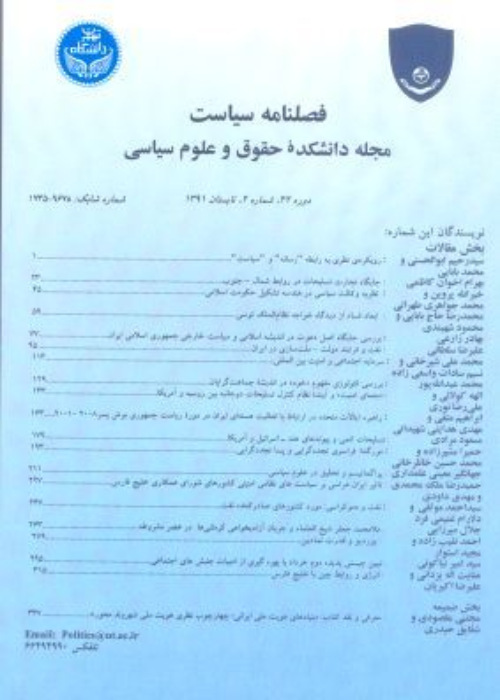Transition in Strategic Priorities of the Islamic Republic Foreign Policy: From “Neither East, Nor West” to “Look to the East”
The geographical, cultural, and economic position of contemporary Iran has invariably induced the ruling elites to adopt the logic of balance in the international politics to preserve national independence and interests against external powers. This is a logic that enables the containment of one aggressive and expansionist state through the expansion of cooperation with its rival or adversarial states— relying on the protagonists (the relatively good guys) to deter the antagonists (the bad guys). The conduct and direction of foreign relations of Iran have changed substantially since the overthrow of the pro-western monarchy. With the victory of the 1979 Islamic Revolution, the perception of Iran's foreign policy makers of the nature of the international system changed, and attentively opposing foreign domination became the main component of foreign policy formulation. A clear transition in Iran’s foreign policy orientations is evident in its relations with the great powers. The Pahlavi regime’s policy of looking to the West, the post-revolution policies of rejecting both the West and the East, and the consideration of looking to the East policy by the current foreign policy makers in Iran could be explained by this logic. The policy of “neither East, nor West, but the Islamic Republic” was introduced during the anti-Pahlavi protests and was founded on the revolutionary ideal of “Independence, Liberty, the Islamic Republic” in 1979. The slogan of “neither East, nor West- but the Islamic Republic” (nah sharqi, nah gharbi– amā Jomhouri-e eslāmī-ʼi) was recognized as a key principle to guide foreign policy goals and behaviors in Article 152 of the Constitution of the Islamic republic of Iran (IRI). Historically, the mantra of “neither East, nor West” has been activated whenever bipolarity gains momentum in the international system, and small and medium powers had no choice for the preservation of their national interest than joining either one of the two superpowers of the East or West. The “neither East, nor West” policy rejected the alliance with the superpowers and called for neutrality since it was argued that both superpowers had been in favor of maximizing their own powers at the expense of the rest of global community. The history has shown that their first priorities had been their national interest. As a result, the two power blocs have been conceived to be similar and on the same side of one global arrogance which repeatedly ignored the rights of the oppressed. With such a pessimistic view, the Islamic Republic of Iran rejected dependence on either of the world powers and opted for self-reliance in foreign relations. With the end of the Cold War, the fall of the Soviet Union, and the hope for multipolarity in international system, this foreign policy outlook of the Islamic Republic was somehow moderated. The IRI actively entered the global political equations as a regional power. Using the theoretical framework of neorealism, the author attempts to find answers to the following two research questions: 1. To what extent have the main principles that guided Iran's foreign policy changed? 2. What domestic and external factors led to the change in Iran’s foreign policy from the “Neither East nor West” to the “Look to the East” policy? In the research hypothesis, it is argued that the new international security environment that emerged with the transformation of the nature of the international system after the fall of the USSR and the end of the Cold War as well as the anti-Iran US-imposed sanctions forced Iranian leaders to gradually revise the foreign policy of “Neither West, Nor East” calling for rejecting dependence on the great powers to the “Look to the East” policy. To find answers to the research questions, the author draws on policy statements made by Iranian government officials, formal document analysis, and the evidence provided in the works of analysts and theorists who have tried to explain Iran’s post-revolution foreign policy. To elaborate on the core factors which influence the making of foreign policy of Iran, he emphasizes the escalation of US-Iran tensions, Iranian leaders’ determination to challenge the US hegemony and unilateralism, and the deterioration of East-West relations that increased the chances of forming a united front against the Western domination with help of the great Eastern powers. Iran’s foreign policies at different post-revolution time-periods—particularly the three policies of moderate revolutionism, 'uma’garai of supporting Muslims and liberation movements, and finally pragmatism— are analyzed. In conclusion, it is argued that the success of Iran’s foreign policy requires a proper degree of accommodation and normalization of relations with the West based on mutual respect, shared interests, and multilateralism to avoid disproportionate, one-sided dependence on the East, which would lead to perilous limitation on Iran’s choices in foreign policy.
- حق عضویت دریافتی صرف حمایت از نشریات عضو و نگهداری، تکمیل و توسعه مگیران میشود.
- پرداخت حق اشتراک و دانلود مقالات اجازه بازنشر آن در سایر رسانههای چاپی و دیجیتال را به کاربر نمیدهد.


